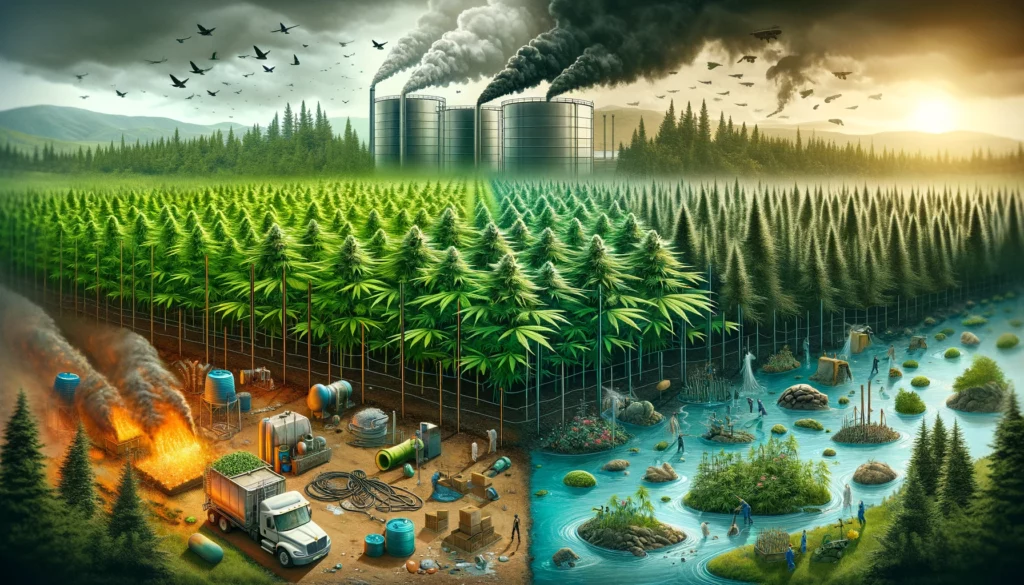As the legalization of marijuana spreads across various regions, the cultivation of this once-illicit plant is rapidly transitioning into a legitimate industry. While the economic and medicinal benefits of marijuana are widely discussed, its environmental impact is less frequently highlighted. This article delves into the environmental consequences of growing marijuana, exploring energy consumption, water usage, pesticide application, and land use, along with potential mitigation strategies.
Energy Consumption
One of the most significant environmental concerns associated with marijuana cultivation is its high energy consumption. Indoor growing operations, which are prevalent in many legal markets due to regulatory and climate considerations, require substantial electricity to power grow lights, ventilation systems, and climate control.
Lighting and Climate Control
Cannabis plants require intense light for optimal growth, often provided by high-intensity discharge (HID) lamps or light-emitting diodes (LEDs). HID lamps, though effective, consume a large amount of electricity. Additionally, maintaining the ideal temperature and humidity levels for cannabis growth involves running HVAC systems continuously, further increasing energy demand.
Carbon Footprint
The energy-intensive nature of indoor cultivation results in a considerable carbon footprint. A study by the Lawrence Berkeley National Laboratory estimated that indoor cannabis cultivation in the United States contributes to 1% of the nation’s total electricity consumption, translating into significant greenhouse gas emissions. Efforts to reduce this impact include the adoption of more energy-efficient lighting technologies, such as LEDs, and utilizing renewable energy sources.
Water Usage
Water is a critical resource for marijuana cultivation, and its usage can vary widely depending on the growing method and location. Both indoor and outdoor cultivation require significant amounts of water, though the impacts and efficiencies differ.
Outdoor Cultivation
Outdoor marijuana cultivation relies on natural water sources such as rivers, lakes, and groundwater. In areas where water is scarce, this can lead to significant strain on local water supplies, affecting both ecosystems and human communities. Illegal cultivation operations, in particular, often draw water unsustainably, exacerbating drought conditions.
Indoor Cultivation
Indoor cultivation can be more water-efficient due to controlled irrigation systems that minimize waste. However, it still requires substantial water input, particularly in regions where water must be transported or treated before use. The runoff from indoor grow operations can also pose environmental hazards if it contains high levels of nutrients or pesticides.
Pesticide and Chemical Use
The use of pesticides and other chemicals in marijuana cultivation is another environmental concern. These substances can have detrimental effects on local ecosystems, including soil degradation and water contamination.
Chemical Runoff
Pesticides, fertilizers, and other chemicals used in cannabis cultivation can leach into the soil and waterways, leading to contamination. This runoff can harm aquatic life, disrupt ecosystems, and pose risks to human health. Organic and sustainable growing practices are becoming more popular as a means to mitigate these impacts.
Integrated Pest Management
To reduce the reliance on chemical pesticides, many growers are adopting integrated pest management (IPM) strategies. IPM focuses on using a combination of biological control agents, environmental modifications, and mechanical controls to manage pests. This approach not only reduces chemical usage but also promotes healthier plants and ecosystems.
Land Use and Habitat Destruction
The expansion of marijuana cultivation, especially outdoor growing operations, can lead to significant land use changes and habitat destruction.
Deforestation
In regions where marijuana cultivation is expanding, there is often a corresponding increase in deforestation. Forested areas are cleared to make way for grow sites, leading to habitat loss for wildlife and decreased biodiversity. This is particularly concerning in ecologically sensitive areas like the Amazon rainforest, where illegal cultivation can exacerbate deforestation rates.
Soil Erosion and Degradation
Marijuana cultivation can also contribute to soil erosion and degradation. The removal of vegetation and the subsequent planting of cannabis can destabilize soil, leading to increased erosion, especially on sloped terrains. Additionally, the heavy use of fertilizers can degrade soil quality over time, reducing its productivity and health.
Mitigation Strategies
Addressing the environmental impact of marijuana cultivation requires a multifaceted approach that includes policy changes, technological innovations, and sustainable farming practices.
Sustainable Growing Practices
Encouraging sustainable growing practices is crucial. This includes the use of organic farming techniques, water-saving irrigation methods, and renewable energy sources. For example, growers can use drip irrigation systems to reduce water waste and install solar panels to offset electricity consumption.
Regulatory Measures
Governments can play a key role by implementing regulations that promote environmentally friendly cultivation practices. This could include setting limits on water and energy usage, enforcing strict pesticide regulations, and providing incentives for growers who adopt sustainable practices.
Research and Education
Investing in research and education is essential to develop new technologies and methods that reduce the environmental impact of marijuana cultivation. Universities, agricultural extension programs, and industry groups can collaborate to conduct research on sustainable practices and disseminate this information to growers.
Conclusion
The environmental impact of growing marijuana is a complex issue that encompasses energy consumption, water usage, pesticide application, and land use. While the industry presents significant economic opportunities, it also poses environmental challenges that need to be addressed. By adopting sustainable practices, implementing regulatory measures, and investing in research and education, the marijuana industry can reduce its environmental footprint and contribute to a more sustainable future.



